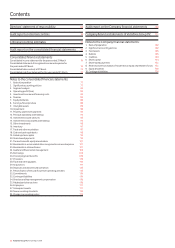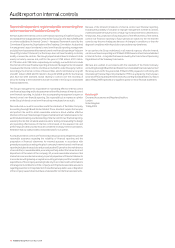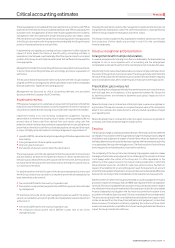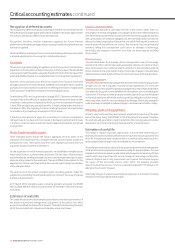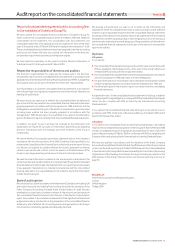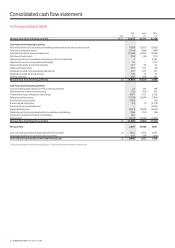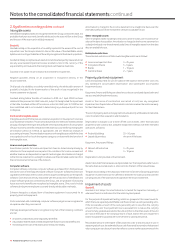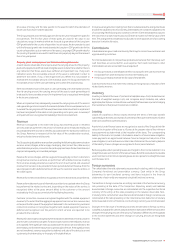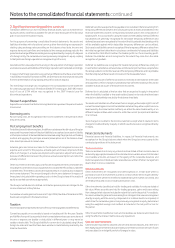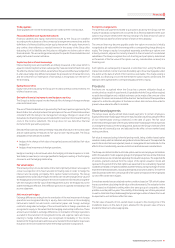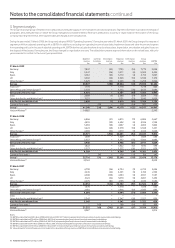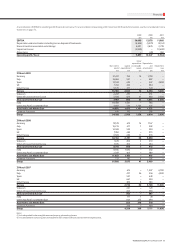Vodafone 2009 Annual Report Download - page 79
Download and view the complete annual report
Please find page 79 of the 2009 Vodafone annual report below. You can navigate through the pages in the report by either clicking on the pages listed below, or by using the keyword search tool below to find specific information within the annual report.
Financials
Vodafone Group Plc Annual Report 2009 77
1. Basis of preparation
The consolidated financial statements are prepared in accordance with IFRS as
issued by the IASB. The consolidated financial statements are also prepared in
accordance with IFRS adopted by the EU, the Companies Act 1985 and Article 4 of
the EU IAS Regulations.
The preparation of financial statements in conformity with IFRS requires management
to make estimates and assumptions that affect the reported amounts of assets and
liabilities and disclosure of contingent assets and liabilities at the date of the financial
statements and the reported amounts of revenue and expenses during the reporting
period. For a discussion on the Group’s critical accounting estimates see “Critical
accounting estimates” on page 71. Actual results could differ from those estimates.
The estimates and underlying assumptions are reviewed on an ongoing basis.
Revisions to accounting estimates are recognised in the period in which the estimate
is revised if the revision affects only that period or in the period of the revision and
future periods if the revision affects both current and future periods.
Amounts in the consolidated financial statements are stated in pounds sterling.
Change in accounting policy
During the year, the Group changed its accounting policy with respect to the
acquisition of minority interests in subsidiaries. Results for the years ended 31 March
2005, 2006 and 2007 have been restated. Further details are provided in note 39 to
the consolidated financial statements.
2. Signicant accounting policies
Accounting convention
The consolidated financial statements are prepared on a historical cost basis except
for certain financial and equity instruments that have been measured at fair value.
Basis of consolidation
The consolidated financial statements incorporate the financial statements of the
Company and entities controlled, both unilaterally and jointly, by the Company.
Accounting for subsidiaries
A subsidiary is an entity controlled by the Company. Control is achieved where the
Company has the power to govern the financial and operating policies of an entity so
as to obtain benefits from its activities.
The results of subsidiaries acquired or disposed of during the year are included in the
income statement from the effective date of acquisition or up to the effective date of
disposal, as appropriate. Where necessary, adjustments are made to the financial
statements of subsidiaries to bring their accounting policies into line with those used
by the Group.
All intra-group transactions, balances, income and expenses are eliminated
on consolidation.
Minority interests in the net assets of consolidated subsidiaries are identified
separately from the Group’s equity therein. Minority interests consist of the amount
of those interests at the date of the original business combination and the minority’s
share of changes in equity since the date of the combination. Losses applicable to
the minority in excess of the minority’s share of changes in equity are allocated
against the interests of the Group except to the extent that the minority has a
binding obligation and is able to make an additional investment to cover the losses.
Business combinations
The acquisition of subsidiaries is accounted for using the purchase method. The cost of
the acquisition is measured at the aggregate of the fair values, at the date of exchange,
of assets given, liabilities incurred or assumed, and equity instruments issued by the
Group in exchange for control of the acquiree, plus any costs directly attributable to the
business combination. The acquiree’s identifiable assets and liabilities are recognised
at their fair values at the acquisition date.
Goodwill arising on acquisition is recognised as an asset and initially measured at
cost, being the excess of the cost of the business combination over the Group’s
interest in the net fair value of the identifiable assets, liabilities and contingent
liabilities recognised.
The interest of minority shareholders in the acquiree is initially measured at the
minority’s proportion of the net fair value of the assets, liabilities and contingent
liabilities recognised.
Where the Group increases its interest in an entity such that control is achieved,
previously held identifiable assets, liabilities and contingent liabilities of the acquired
entity are revalued to their fair value at the date of acquisition, being the date at which
the Group achieves control of the acquiree. The movement in fair value is taken to
the asset revaluation surplus.
Acquisition of interests from minority shareholders
Acquisitions of minority interests in subsidiaries are accounted for as transactions
bet ween shareholders. There is no remeasurement to fair value of net assets acquired
that were previously attributable to minority shareholders.
Interests in joint ventures
A joint venture is a contractual arrangement whereby the Group and other parties
undertake an economic activity that is subject to joint control; that is, when the
strategic financial and operating policy decisions relating to the activities require the
unanimous consent of the parties sharing control.
The Group reports its interests in jointly controlled entities using proportionate
consolidation. The Group’s share of the assets, liabilities, income, expenses and cash
flows of jointly controlled entities are combined with the equivalent items in the
results on a line-by-line basis.
Any goodwill arising on the acquisition of the Group’s interest in a jointly controlled
entity is accounted for in accordance with the Group’s accounting policy for goodwill
arising on the acquisition of a subsidiary.
Investments in associates
An associate is an entity over which the Group has significant influence and that is
neither a subsidiary nor an interest in a joint venture. Significant influence is the
power to participate in the financial and operating policy decisions of the investee
but is not control or joint control over those policies.
The results and assets and liabilities of associates are incorporated in the consolidated
financial statements using the equity method of accounting. Under the equity
method, investments in associates are carried in the consolidated balance sheet at
cost as adjusted for post-acquisition changes in the Group’s share of the net assets
of the associate, less any impairment in the value of the investment. Losses of an
associate in excess of the Group’s interest in that associate are not recognised.
Additional losses are provided for, and a liability is recognised, only to the extent that
the Group has incurred legal or constructive obligations or made payments on behalf
of the associate.
Any excess of the cost of acquisition over the Group’s share of the net fair value of the
identifiable assets, liabilities and contingent liabilities of the associate recognised at
the date of acquisition is recognised as goodwill. The goodwill is included within the
carrying amount of the investment.
The licences of the Group’s associated undertaking in the US, Verizon Wireless, are
indefinite lived assets as they are subject to perfunctory renewal. Accordingly, they
are not subject to amortisation but are tested annually for impairment, or when
indicators exist that the carrying value is not recoverable.
Notes to the consolidated nancial statements



